Rakuten Mobile was allocated platinum band frequencies (low frequency radio waves) in October 2023. The bandwidth is narrow, a total of 6MHz wide. Specifically, Rakuten Mobile was allocated radio waves in the 700MHz band (band 28) FDD (Frequency Division Duplex) system frequency band.
This article explains the characteristics of the 700MHz (Band 28) frequency allocated to Rakuten Mobile. We will explain the characteristics of this frequency. We will also explain what services can be provided with this platinum band (700MHz band) frequency.
Rakuten Mobile began limited services on the 700MHz (Band 28) frequency in June 2024. However, Rakuten Mobile is using KDDI’s 800MHz (band 18) on a large scale through roaming.
- Rakuten Mobile’s 700MHz band (Band 28) Platinum band
- Frequencies owned by Rakuten Mobile
- What is a platinum band (mobile low band)?
- Mobile low band frequency allocation status in Japan: Docomo, KDDI, Softbank and Rakuten Mobile
- Rakuten Mobile services using the platinum band (low band)
- Benefits of Rakuten Mobile’s narrowband 700MHz (Band 28) service
- Rakuten Mobile’s narrowband 700MHz (Band 28) data speed problem
- Rakuten Mobile’s narrowband 700MHz (Band 28) user and traffic capacity issues
- Rakuten Mobile’s narrowband 700MHz (Band 28) service
- Rakuten Mobile roams on KDDI (800MHz, band 16/18)
- Rakuten Mobile adopts US AST SpaceMobile satellite communications
- Summary
Rakuten Mobile’s 700MHz band (Band 28) Platinum band
Rakuten Mobile’s platinum band, the 700MHz band, is only 6MHz wide in total
The platinum band allocated to Rakuten Mobile is a frequency in the 700MHz range. For 4G LTE, this frequency band is specified by 3GPP as band28. Frequencies in this range are used in mobile communications for FDD (frequency division multiplexing). For this reason, frequencies for uplink and downlink communications were paired and allocated separately.
The frequencies allocated to Rakuten Mobile are a 3MHz wide band from 715.0MHz to 718.0MHz for the uplink and a 3MHz wide band from770.0MHz to 773.0MHz for the downlink, for a total of 6MHz wide. (See the diagram below)
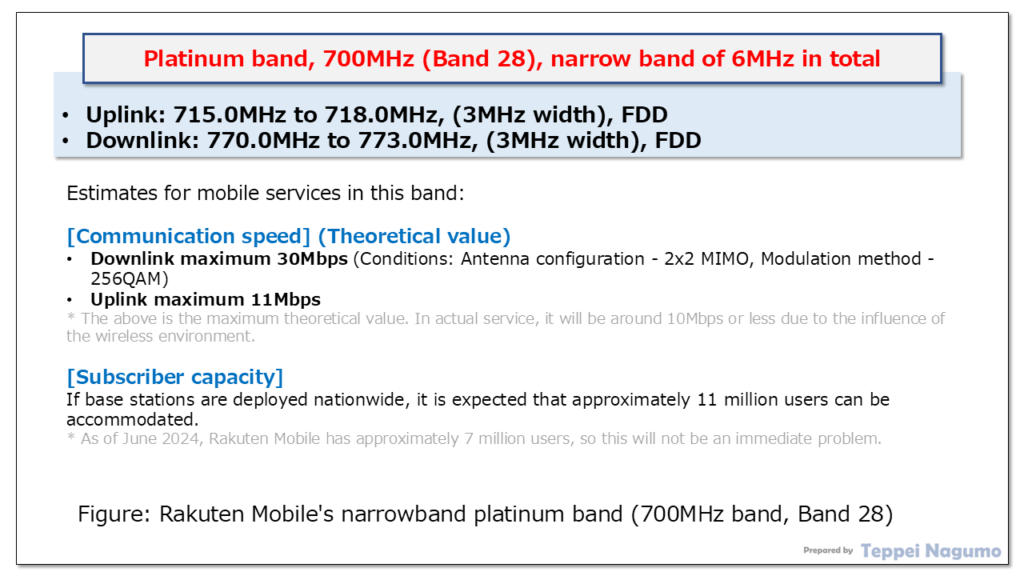
Consideration of re-allocation of platinum band in Japan
The platinum band is a frequency band that is easy to secure a mobile communication area. Furthermore, the available frequency bandwidth is narrow, making it a very valuable frequency band. That’s why it’s called the platinum band.
In Japan, the platinum band frequencies used for mobile communications are the 700MHz band (band 28), 800MHz band (band 26/18/19), and 900MHz band (band 8). There was consideration of reorganizing the allocation of this platinum band to each mobile communication operator. The main reason for this consideration was that Rakuten Mobile did not have frequencies in this band.
Frequencies owned by Rakuten Mobile
The specific frequencies owned by Rakuten Mobile are summarized in the table below. Rakuten Mobile operates its mobile communications business in Japan, providing 5G NR and 4G LTE services using the following frequencies. The frequency of the 700MHz platinum band (Band 28) allocated to Rakuten Mobile is also included in the table.
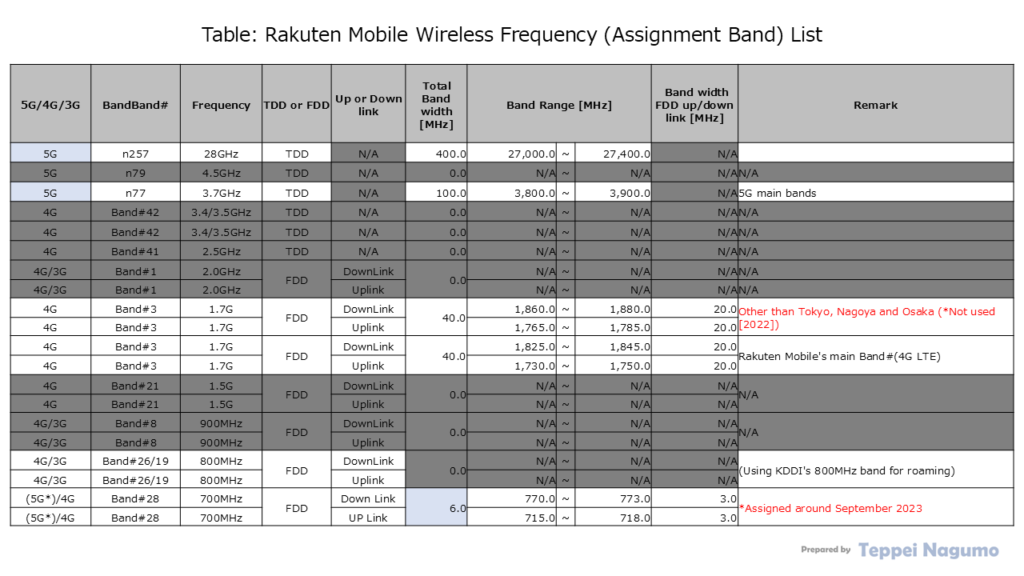
Rakuten Mobile provides 4G LTE services throughout Japan, primarily using frequencies in the 1.7GHz band (Band 3). Rakuten Mobile has the largest number of base stations in the 1.7GHz band. 5G services are provided using frequencies in the 3.7GHz band (n77/n78).
For details on the number of Rakuten Mobile base stations (as of the end of March 2023), please refer to the following article.
The graph below shows the frequencies owned by Rakuten Mobile and their bandwidths. The graph also shows the frequency of the 700MHz band (Band 28) newly allocated to Rakuten Mobile. The graph shows that the platinum band allocated to Rakuten Mobile is a low frequency and has a very narrow bandwidth.
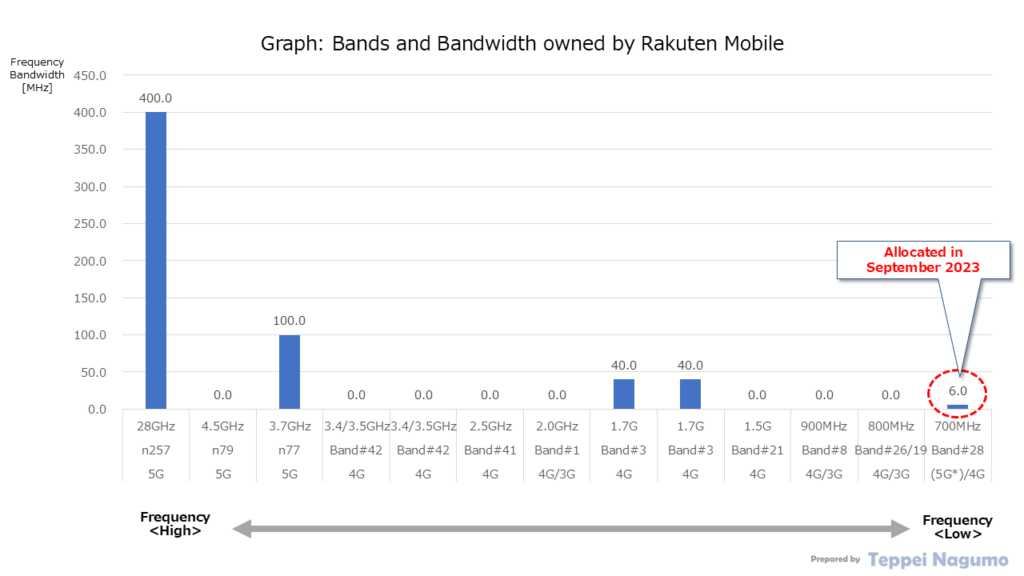
What is a platinum band (mobile low band)?
Platinum bands and their characteristic
Among the frequencies used for mobile communication, the platinum band is the lowest frequency radio wave. This low frequency has the characteristic that it has good radio wave propagation, but does not have a high communication speed. (See the figure below)
The figure below summarizes the characteristics of the frequency bands and their radio waves. Low-frequency radio waves (platinum band) have good radio wave propagation. Low-frequency radio waves can reach buildings and obstacles. They also easily penetrate walls of buildings. Therefore, it is easy to secure a communication area inside a building (indoors).
In other words, low-frequency radio waves (platinum band) are very effective in securing a wide wireless area for mobile communication.
It is difficult to secure a wide frequency band for low-frequency radio waves (platinum band). Low-frequency bands are used for various purposes because they are radio waves that are easy to secure areas where wireless communication is possible. Therefore, it is basically necessary to communicate using a narrow frequency band.
In other words, it is difficult for low-frequency radio waves (platinum band) to process large amounts of traffic or achieve high communication speeds in wireless communication.
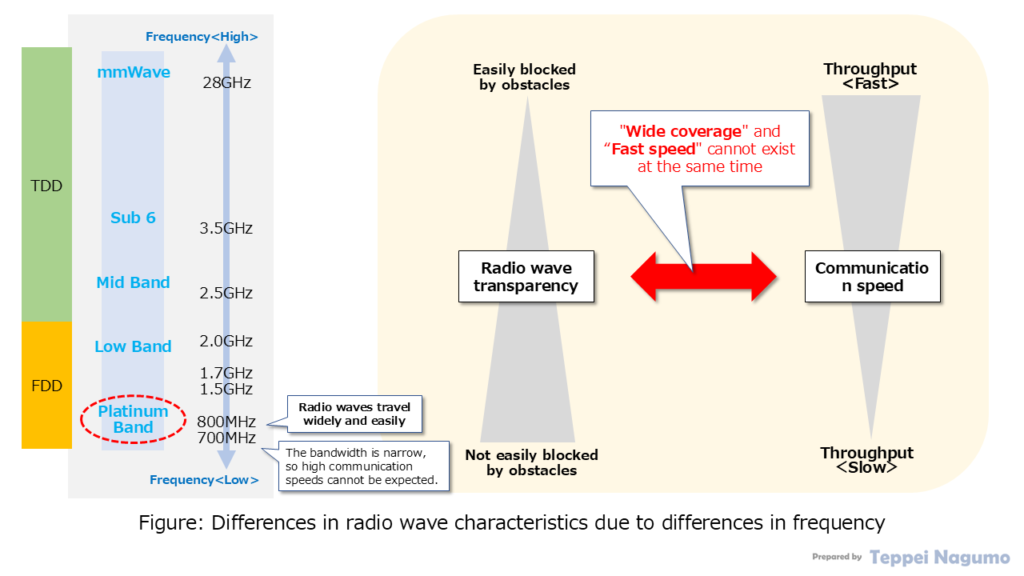
For more information on the relationship between mobile phone wireless area and communication speed due to differences in wireless bands, please see the article below (only Japanese version avirable).
Mobile low band frequency allocation status in Japan: Docomo, KDDI, Softbank and Rakuten Mobile
The platinum band is the lowest frequency in Japan that is used for mobile communications such as 5G/4G. The frequencies considered platinum bands for mobile communications in Japan are 700MHz (band 28), 800MHz (bands 26/18/19), and 900MHz (band 8).
The exact bands allocated for mobile communications in this platinum band and the mobile carriers that own those bands are summarized in the table below.
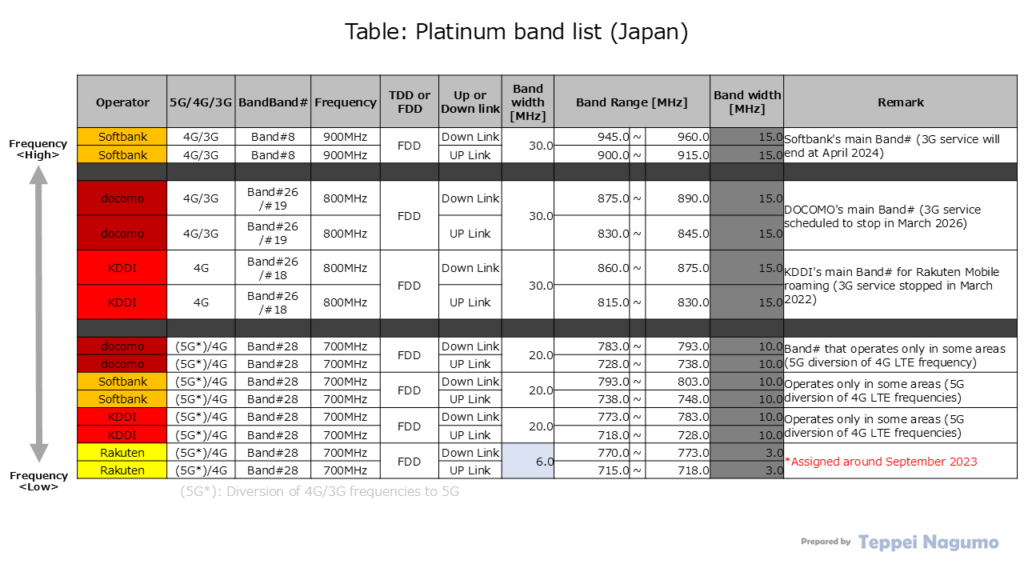
In the 700MHz (Band 28), 800MHz (Band 26/18/19), and 900MHz (Band 8), mobile operators are assigned frequencies in the range of 10MHz to 15MHz for uplink and downlink, respectively.
The diagram below visualizes the frequency allocation status of Japan’s platinum band. The diagram shows the frequency band, the band name (band name) and its exact band specified by 3GPP, and the exact frequencies assigned to each telecommunications company and their adjacent relationships.
The diagram below also shows the frequencies in the platinum band, 700MHz band (Band 28), assigned to Rakuten Mobile.
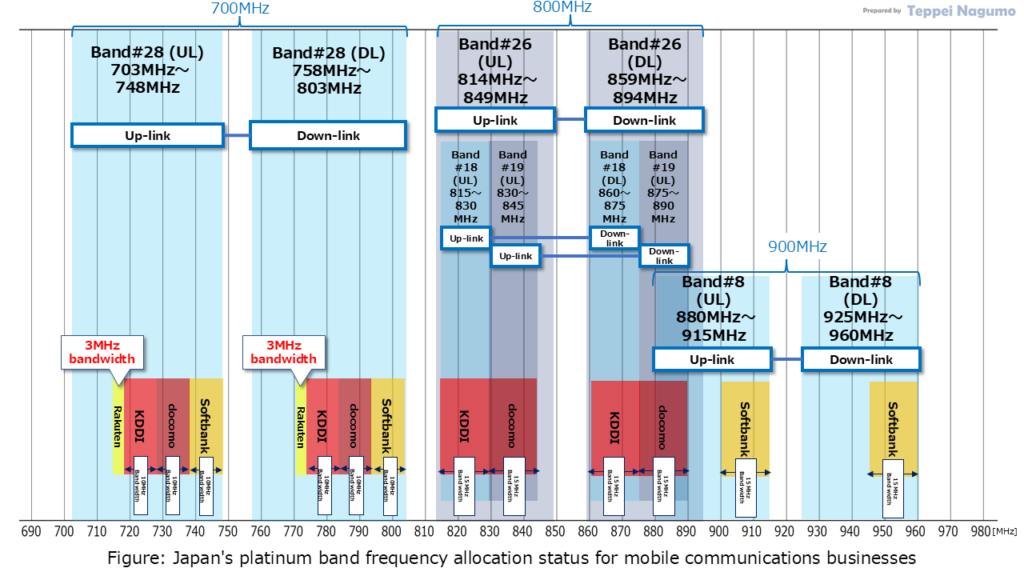
Please refer to the following website for a diagram showing details of the bands allocated to mobile operators in the low band, sub-6, and millimeter wave bands other than the platinum band.
Rakuten Mobile services using the platinum band (low band)
This article explains the benefits of Rakuten Mobile using the 700 MHz band (Band 28) to provide services. It also explains the anticipated problems associated with services using the 700 MHz band (Band 28).
Benefits of Rakuten Mobile’s narrowband 700MHz (Band 28) service
By using the platinum band 700MHz (Band 28), Rakuten Mobile can secure a wide wireless service area. In particular, it will enable communication in indoor areas in urban areas such as Tokyo that could not be covered by the 1.7GHz band (Band 3), as well as in areas that were previously out of service due to shadows of buildings and obstacles.
700MHz (Band 28) radio waves are easier to expand the wireless area where service is available. This is because 700MHz radio waves travel better, go around obstacles, and easily penetrate building walls.
By deploying its own platinum band 700MHz (Band 28) base stations nationwide, Rakuten Mobile can reduce roaming of 800MHz (Band 16/18) bands from KDDI.
Rakuten Mobile’s narrowband 700MHz (Band 28) data speed problem
There are also problems specific to narrowband radio waves in the 700MHz band (Band 28). The narrowband frequency of 6MHz in total (uplink 3MHz, downlink 3MHz) does not provide high communication speeds.
Theoretically, the maximum downlink communication speed is 30Mbps (conditions: 2×2 MIMO antenna, 256QAM modulation method). Therefore, in an actual wireless environment, the communication speed will be 10Mbps or less. It is difficult to enjoy YouTube on a smartphone with communication only in the 700MHz band.
Rakuten Mobile’s narrowband 700MHz (Band 28) user and traffic capacity issues
If the number of Rakuten Mobile users increases in the future, it is thought that the 6 MHz bandwidth of the 700 MHz band (Band 28) will be unable to accommodate many users (subscribers).
According to NTT Docomo’s calculations, it is possible to accommodate 11 million users across Japan. As of June 2024, Rakuten Mobile has approximately 7 million subscribers, so it is not likely to be a problem for the time being. If the number of Rakuten Mobile subscribers increases in the future, or if the amount of user traffic increases, it is possible that the 6 MHz bandwidth of the 700 MHz band (Band 28) will not be able to accommodate them.
Rakuten Mobile’s narrowband 700MHz (Band 28) service
Rakuten Mobile’s narrowband 700MHz (Band 28) service uses NOKIA radio units (RU: Radio Units). There are no plans to deploy large numbers of 700MHz Rakuten Mobile radios, as evidenced by the fact that they are roaming on the 800MHz band from KDDI.
Rakuten Mobile website, Rakuten Mobile adopts Nokia radio equipment for base station deployment in the “Platinum Band” 700MHz band [link]
Rakuten Mobile roams on KDDI (800MHz, band 16/18)
Rakuten Mobile compensates for areas that cannot be covered by its own wireless area by roaming on KDDI’s 800MHz band (band 16/18). It mainly roams on KDDI’s 800MHz frequency in rural areas where its own base stations cannot cover the wireless area. In addition, it compensates for areas in urban areas where Rakuten Mobile cannot cover with its own wireless by roaming on this KDDI 800MHz frequency.
KDDI’s 800MHz band (band 16/18) is a frequency band with an uplink width of 15MHz and a downlink width of 15MHz. There are approximately 73,000 4G LTE base stations installed throughout Japan. This frequency covers sparsely populated rural areas and areas where wireless communication is possible, even indoor areas.
The roaming contract between KDDI and Rakuten Mobile and the exact roaming areas are published on the KDDI official website below.
KDDI website, Rakuten Mobile roaming service area (map), [link] – only Japanese
Rakuten website, KDDI and Rakuten Mobile Reach New Roaming Agreement, May 11, 2023, [link]
Rakuten Mobile adopts US AST SpaceMobile satellite communications
Rakuten Mobile is planning to communicate with the artificial satellites of the US company AST SpaceMobile. This is a method in which smartphones communicate directly with the artificial satellites of AST SpaceMobile. Since communication with artificial satellites covers the entirety of Japan, Rakuten Mobile may focus on this.
Rakuten mobile press-release, Rakuten Mobile Announces Plans to Provide Satellite-to-Mobile Service in Japan with AST SpaceMobile Starting in 2026, February 16, 2024, [link]
Summary
We explained the 700MHz (Band 28) frequency band radio waves in the platinum band allocated to Rakuten Mobile. We also explained the characteristics of platinum band radio waves in general. We also explained the advantages and disadvantages of using the platinum band for mobile communications.
We also explained how platinum band frequencies are allocated to mobile communications carriers in Japan (Docomo, KDDI, Softbank, and Rakuten Mobile).
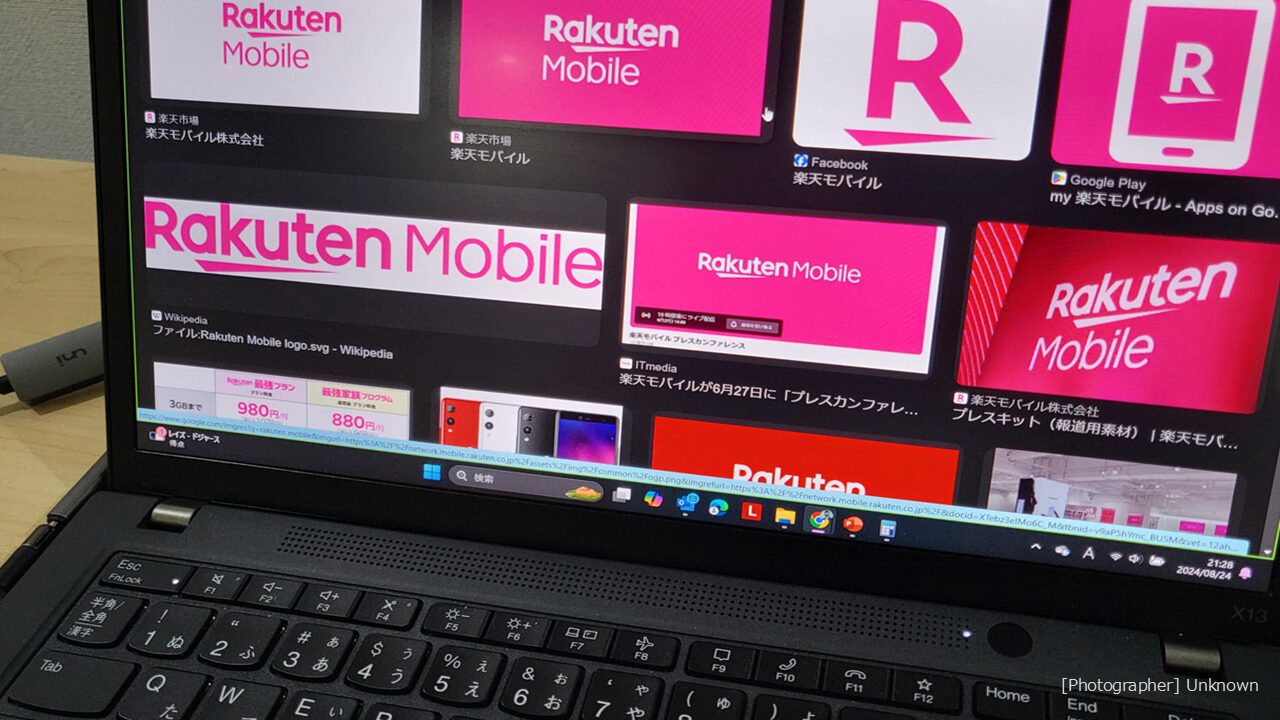





コメント